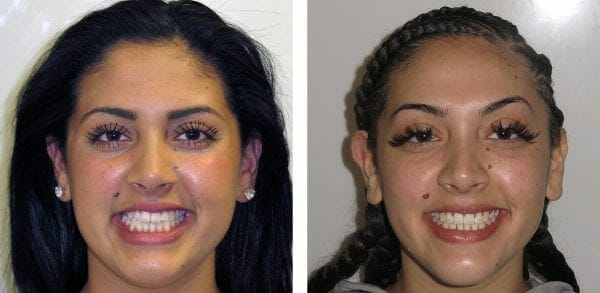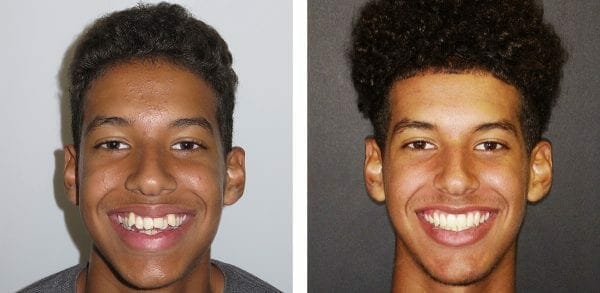Orthodontist-Approved Tips for Teens in Braces
Is it Normal to Feel Apprehensive About Getting Braces?
Of course, each person is different, but some teens can be apprehensive about going to the orthodontist, which is completely normal. While some children and adults may feel hesitation about orthodontic treatment, children are usually too young to fully understand that the course of treatment is straightforward. Most adults often see it as nothing to worry over.
However, for teenagers, getting braces is an unknown experience and they may worry about the social implications of undergoing orthodontic treatment.
How Many Teens Get Braces Per Year?
 Out of the 2 million people undergoing orthodontic treatment each year in the United States, half of them are teenagers. This means that 50% of all people in braces are between the ages of 13 and 19. This reality can help alleviate a teen’s concern about feeling like they are the only one wearing braces.
Out of the 2 million people undergoing orthodontic treatment each year in the United States, half of them are teenagers. This means that 50% of all people in braces are between the ages of 13 and 19. This reality can help alleviate a teen’s concern about feeling like they are the only one wearing braces.
Most teens find that the thought of having braces is much worse than actually wearing them. In fact, once the braces have been on for a few weeks and a routine has been established, many young people forget they are even on their teeth.
Burke & Redford Orthodontists have board-certified doctors dedicated to helping people of any age feel comfortable and at ease. It is the mission of our doctors to offer patients a stress-free and enjoyable experience throughout the duration of their treatment.
Allow us to provide you with the highest quality orthodontic care at our beautiful offices in Lake Elsinore and Temecula. Call us today at (951) 699-8011 to schedule a free consultation.
What Does a Daily Routine Look Like with Braces?
Before beginning their braces journey, most teens will want to know how their daily routine will change once treatment has started. Our doctors will discuss the recommended care that should be taken by the patient based on their specific needs.
However, the typical routine for oral hygiene that is generally followed by most patients is outlined below:
- Teeth should be brushed well for about 3-4 minutes, 3-4 times per day. It is important to get between the brackets and wiring. Brushing ideally occurs after every meal and right before going to bed.
- Flossing is one of the most important aspects of care while in braces and for a lifetime. It does take a few minutes, but it should be done at least one time per day. The floss itself should be threaded between the wiring of each tooth, which can be made easy by using floss threaders.
- After brushing and flossing your teeth well, replace your elastics as instructed by the orthodontist.
While this daily routine can seem overwhelming at first, most people find it becomes a simple habit. The extra effort of implementing this routine into daily life pays off in the long run by reducing and removing plaque build-up and gum inflammation, which can lead to other dental problems.
What Food Should Be Avoided With Braces?
There are certain foods that should be avoided while wearing braces. Excessively sticky, chewy, or hard foods and substances can disrupt the treatment plan by breaking off brackets or distorting the wires and should not be consumed.
Listed below are the food consistencies and examples of what is off-limits for wearers of braces.
- Sticky (taffy, caramel, gum)
- Chewy (some candy, licorice)
- Hard (nuts, some candy, ice, raw vegetables)
- Crunchy (popcorn, chips, trail mix)
It is advised that vegetables and hard/chewy bread should be cut up into small pieces.
The more treatment is interrupted with broken brackets, the longer they might need to be worn, so it is important to be careful and eat braces-approved foods only.
Can I Play Sports in Braces?

While sports may certainly be played while wearing braces, it is important to wear a mouth guard that protects the teeth, cheeks, lips, and gums while playing sports (especially contact sports). We offer custom and pre-fabricated mouthguards to our patients upon request.
What if I Have a Problem with My Braces?
If you experience any type of problem with the appliance or simply have a question, our doctors and staff are always happy to help address your questions.
Common problems, such as broken brackets and loose wires should be promptly reported to the orthodontic practice during regular office hours. These will be fixed in a timely manner to keep treatment running smoothly.
If a severe orthodontic emergency were to take place, calling the orthodontist’s emergency phone line for guidance is advised. If very severe or if injuries are life threatening, the patient is advised to go to the nearest hospital.
Direct to Consumer vs. Orthodontic Care with a Professional
In the current technology-driven era, teenagers are shown many different types of braces options across social media platforms. These advertisements often create unrealistic expectations about what is possible with certain types of braces systems and make aggressive promises about how long treatment will take.
There are several aligner companies that offer their trays as a direct-to-consumer service that sounds attractive to some.
While offers like this may be intriguing, quick-fix products that attempt to replace orthodontist-guided treatment contain some significant flaws, such as:
- There is no initial consultation with a professional, licensed orthodontist, such as Dr. Redford or Dr. Burke. Instead, a discussion is led by a sales representative.
- Initial x-rays images are not taken. These radiographs provide important information about the structures surrounding teeth and underneath the gums. Complete records, including x-rays, are critical to establishing a proper diagnosis and avoiding potential harm.
- Underlying, pre-existing issues like gum disease and bone loss may be missed. Beginning orthodontic treatment before treating these issues could be detrimental to the patient’s oral health.
- There is no qualified orthodontist to construct a treatment plan personalized for the individual. A one-size-fits-all approach may work occasionally but will not achieve consistently great results.
- Follow-up treatment and adjustment with a qualified, board-certified orthodontist in person is not available. When teeth don’t move as predicted or unforeseen challenges arise, having access to a professional with several “tools” at their disposal can be invaluable.
- Many who have gone through this type of treatment have had additional orthodontic problems arise that then need to be addressed and corrected with a professional. This can end up being quite costly and add time and effort into correcting.
When considering orthodontic treatment, a prospective patient should know that the results achieved in treatment are the direct result of the treating orthodontist, not the brand of braces or aligners used.
How Can I Begin Treatment?
If you or your child or teen is ready to begin the next steps toward a beautiful smile, Burke & Redford Orthodontists will help you get started and have over 30 years of experience treating patients in Southern California. We give all new patients a complimentary consultation with one of our expert orthodontists at their first visit. Learn more about braces options and even Invis aligners for teens with a free consultation.
Call us today at (951) 699-8011 and we will happily assist you. Our orthodontist offices are located in Temecula and Lake Elsinore.